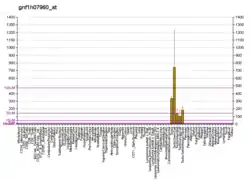CST9L
Cystatin-9-like is a protein that in humans is encoded by the CST9L gene.[5]
The cystatin superfamily encompasses proteins that contain multiple cystatin-like sequences. Some of the members are active cysteine protease inhibitors, while others have lost or perhaps never acquired this inhibitory activity. There are three inhibitory families in the superfamily, including the type 1 cystatins (stefins), type 2 cystatins and the kininogens. The type 2 cystatin proteins are a class of cysteine proteinase inhibitors found in a variety of human fluids and secretions. The cystatin locus on chromosome 20 contains the majority of the type 2 cystatin genes and pseudogenes. This gene is located in the cystatin locus and encodes a protein similar to mouse cystatin 9. Based on its testis-specific expression, it is likely to have a role in tissue reorganization during early testis development.[5]
References
- GRCh38: Ensembl release 89: ENSG00000101435 - Ensembl, May 2017
- GRCm38: Ensembl release 89: ENSMUSG00000027445 - Ensembl, May 2017
- "Human PubMed Reference:". National Center for Biotechnology Information, U.S. National Library of Medicine.
- "Mouse PubMed Reference:". National Center for Biotechnology Information, U.S. National Library of Medicine.
- "Entrez Gene: CST9L cystatin 9-like (mouse)".
Further reading
- Brown WM, Dziegielewska KM (1997). "Friends and relations of the cystatin superfamily--new members and their evolution". Protein Sci. 6 (1): 5–12. doi:10.1002/pro.5560060102. PMC 2143511. PMID 9007972.
- Saitoh E, Isemura S, Sanada K, et al. (1989). "Cystatin superfamily. Evidence that family II cystatin genes are evolutionarily related to family III cystatin genes". Biol. Chem. Hoppe-Seyler. 369 Suppl: 191–7. PMID 3202964.
- Dickinson DP, Thiesse M, Dempsey LD, Millar SJ (1993). "Genomic cloning, physical mapping, and expression of human type 2 cystatin genes". Crit. Rev. Oral Biol. Med. 4 (3–4): 573–80. doi:10.1177/10454411930040034401. PMID 7690606.
- Dickinson DP, Zhao Y, Thiesse M, Siciliano MJ (1995). "Direct mapping of seven genes encoding human type 2 cystatins to a single site located at 20p11.2". Genomics. 24 (1): 172–5. doi:10.1006/geno.1994.1595. PMID 7896273.
- Thiesse M, Millar SJ, Dickinson DP (1994). "The human type 2 cystatin gene family consists of eight to nine members, with at least seven genes clustered at a single locus on human chromosome 20". DNA Cell Biol. 13 (2): 97–116. doi:10.1089/dna.1994.13.97. PMID 8179826.
- Eriksson A, Töhönen V, Wedell A, Nordqvist K (2002). "Isolation of the human testatin gene and analysis in patients with abnormal gonadal development". Mol. Hum. Reprod. 8 (1): 8–15. doi:10.1093/molehr/8.1.8. PMID 11756564.
- Deloukas P, Matthews LH, Ashurst J, et al. (2002). "The DNA sequence and comparative analysis of human chromosome 20". Nature. 414 (6866): 865–71. doi:10.1038/414865a. PMID 11780052.
- Strausberg RL, Feingold EA, Grouse LH, et al. (2003). "Generation and initial analysis of more than 15,000 full-length human and mouse cDNA sequences". Proc. Natl. Acad. Sci. U.S.A. 99 (26): 16899–903. doi:10.1073/pnas.242603899. PMC 139241. PMID 12477932.
- Clark HF, Gurney AL, Abaya E, et al. (2003). "The secreted protein discovery initiative (SPDI), a large-scale effort to identify novel human secreted and transmembrane proteins: a bioinformatics assessment". Genome Res. 13 (10): 2265–70. doi:10.1101/gr.1293003. PMC 403697. PMID 12975309.
- Zhang Z, Henzel WJ (2005). "Signal peptide prediction based on analysis of experimentally verified cleavage sites". Protein Sci. 13 (10): 2819–24. doi:10.1110/ps.04682504. PMC 2286551. PMID 15340161.
- Gerhard DS, Wagner L, Feingold EA, et al. (2004). "The status, quality, and expansion of the NIH full-length cDNA project: the Mammalian Gene Collection (MGC)". Genome Res. 14 (10B): 2121–7. doi:10.1101/gr.2596504. PMC 528928. PMID 15489334.




